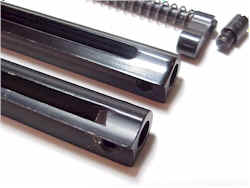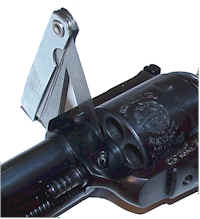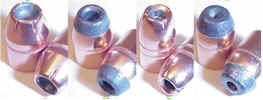
 Okay, I’ll admit it, when it comes to unnecessary spending to make a gun look better, I get in line with everyone else. I think I mentioned in the first part of this series, the Ruger was not going to win any slick finish awards. The ejector rod housing is one of the sore points, sort of whittled out of a piece of aluminum with a dull pocket knife, then colored with a half empty magic marker. That’s the standard part on the bottom if you missed it.
Okay, I’ll admit it, when it comes to unnecessary spending to make a gun look better, I get in line with everyone else. I think I mentioned in the first part of this series, the Ruger was not going to win any slick finish awards. The ejector rod housing is one of the sore points, sort of whittled out of a piece of aluminum with a dull pocket knife, then colored with a half empty magic marker. That’s the standard part on the bottom if you missed it.
Qualite’ Pistol and Revolver produce several nice pieces for the Ruger Blackhawk: ejector rod housings, standard and custom grip frames, crescent head ejector rods, and gunsmithing services. You can buy the hardware directly from Qualite, or go to an outlet like Brownells, probably getting a better deal on price and delivery. $28 from Brownells, $38 from Qualite.
 The new piece is installed by removing the single retaining screw and the housing, swapping the ejector rod and spring from the original part into the new housing, and reinstalling the new assembly back in place. We’re looking at about 30 seconds worth of effort. Actually I changed mine out during lunch, between bites of a hamburger. And if you pick up a burger from the right place, you’ll probably get just enough oil for the housing assembly.
The new piece is installed by removing the single retaining screw and the housing, swapping the ejector rod and spring from the original part into the new housing, and reinstalling the new assembly back in place. We’re looking at about 30 seconds worth of effort. Actually I changed mine out during lunch, between bites of a hamburger. And if you pick up a burger from the right place, you’ll probably get just enough oil for the housing assembly.
Is there a downside or a risk to making this change ? Absolutely. The housing is now the nicest part of the gun and eventually I’ll be driven to have the whole thing quality refinished, if I can find a service that won’t round off all the corners and lose the stamps. Of course a nice dark blue wouldn’t look right with those rough rosewood grips, so maybe a nice presentation grade walnut would look good. But then I’d be financially so far into the gun, I’d have to get it rechambered for the .475 Linebaugh to make it all worthwhile. I really haven’t actually given it any thought.
Foundation
I spent a lot of time reviewing existing data in current and past reloading manuals, as well as more informal data available from other sources. First it seemed there was a significant difference of opinion as to what levels of pressure and performance the .45 Colt cartridge and firearms could withstand. After further research I found the big variations in loading data and performance could be mostly attributed to guns receiving special treatment; tightened dimensional tolerances, or custom cylinders, and were up to handling hotter loads.
Most mainstream reloading manuals have two handgun sections for the cartridge; one for standard Colts and older handguns in good condition, the other for heavy frame and cylinder firearms such as current model Rugers and Thompson Center Contender/Encore. The more recent the manual the slower the powder for loads using heavier bullets. In early manuals, powder recommendations might be 2400, No.5, No.7 and Unique, more recent publications extend into No.9, Win 296 and H110. Loads in the standard section are typically in the 14,000 c.u.p. range. Loads in the higher intensity load section move up to 25,000 c.u.p.
There were occasions when data from independent sources documented very high velocities, while powder types and charges remained very similar to mainstream reloading manuals. At times, the high velocities were explained as the result of using better sealing and oversized cast bullets, and pushing pressures up into the 30,000 – 35,000 c.u.p. range. In other cases, the revolvers used in testing were blueprinted, or dimensionally optimized at cylinder gaps, chambers and throats.
There was one last category of information. Extraordinary results were being reported, but examination of the loading data revealed it to be the same information appearing in conservative reloading manuals. Reminds me of the time I was able to get 4,200 fps out of my Weatherby with 250 grain bullets, right up until I moved the chronograph electronics away from the blast from the muzzle brake. So I put this category of .45 Colt loads in the “magic bullet” classification, and set them aside for future investigation.
Within the data, one reason for the resurgence in popularity of .45 Colt cartridge becomes more obvious. At the heavier end of the bullet range, the .45 Colt will deliver about the same velocity per grain of bullet weight as the .44 Magnum, only at approximately 38% lower chamber pressure. Not unlike those old British double rifles, using low pressure cordite loads, to throw very large diameter heavy bullets, with significant consequence to whatever was on the receiving end.
| Not valid load data – c.u.p. reference only | |||||
| Cartridge | Bullet | Powder | Charge | Velocity | c.u.p |
| .45 Colt | 250 gr JHP | AA#9 | 15.1 | 950 | 14,000 |
| .45 Colt | 250 gr JHP | AA#9 | 17.8 | 1300 | 25,000 |
| .45 Colt | 260 gr Keith | H-110 | 27.0 | 1491 | 33,000 |
| .45 Colt | 300 gr JSP | W296 | 23.0 | 1193 | 25,000 |
| .44 Mag | 300 gr JSP | W296 | 22.5 | 1187 | 40,000 |
But why stretch the limits of the .45 Colt, when it would seem easier to just move up to the .454 Casull. This change would kick the 300 grain bullet velocities up from 1200 fps to 1500 fps, perhaps even a greater spread for lighter weight bullets. The downside of selecting the .454 Casull would be: a higher initial cost of the firearm, ammo and brass at twice the price of the .45 Colt, some high velocity loads that push the Casull beyond the use of cast bullets, and the Casull has significantly higher levels of recoil.
Within reason, The .45 Colt can yield a broad range of performance from low velocity plinking loads, through high velocity hunting loads, in moderately prices guns, with moderately priced ammo.
Initial Load Data and Baseline Information
 Guns are not perfect and dimensions vary from one to another, within the same brand and model. Some of these variations mean nothing, in terms of ballistic performance, others mean a great deal. As an example, the difference between a .003″ and a .006″ cylinder gap in a gun designed for high pressure loads may be a variation of 100 fps in muzzle velocity. I thought it might be good to note some of these dimensions as a point of reference.
Guns are not perfect and dimensions vary from one to another, within the same brand and model. Some of these variations mean nothing, in terms of ballistic performance, others mean a great deal. As an example, the difference between a .003″ and a .006″ cylinder gap in a gun designed for high pressure loads may be a variation of 100 fps in muzzle velocity. I thought it might be good to note some of these dimensions as a point of reference.
A telescope gauge and accurate digital caliper were used to take chamber and throat measurements. Not the most critical measurement tools, but certainly more than accurate enough for this purpose. The numbers indicated are an average of six readings, however, the actual variation was less than .0005″. In fact, when making other checks such as cylinder runout, cylinder to bore perpendicularity, etc. the gun held very tight tolerances.
 Cylinder gap was measured by loading the cylinder to the rear of the frame and inserting a feeler gauge between the cylinder and barrel. The dimension was between .005″ – .006″ as the .005 was not an extremely tight fit, however the .006″ gauge would not pass through the gap.
Cylinder gap was measured by loading the cylinder to the rear of the frame and inserting a feeler gauge between the cylinder and barrel. The dimension was between .005″ – .006″ as the .005 was not an extremely tight fit, however the .006″ gauge would not pass through the gap.
The firearm used for all .45 Colt test data:
Model: Ruger Bisley
Barrel: 7.5″
Chamber:.482″
Throat:.450″
Cylinder Gap:.005″
I believe the chambers in my Ruger are on the small side, at least in comparison to dimensions I’ve seen on sites promoting the use of reamed .44 mag cylinders to achieve tight .45 Colt cylinders. I do, however, believe the RCBS sizing dies is undersized at .472″, leaving a case head of .476″. Because there is so much surplus case capacity, the smaller diameter isn’t noticed, but the heavy resizing has to be tough on brass. When I get a chance I’ll call RCBS and get a more accurate fix on what typical sizes should be. The case spec in all manuals I have access to, including the “Handloader’s Manual of Cartridge Conversions” is .480″.
The effective barrel length of a 7.5″ Bisley is very close to a 10″ Thompson Center single shot. The single shot 10″ barrel designation includes the length of the chamber. All else being equal, the single shot will typically generate higher muzzle velocity as a result of the single shot having a closed breech and no subsequent loss of pressure to a cylinder gap. The bullets used for this part of the development are all jacketed. There are obviously many excellent cast bullets that may represent better choices for hunting and informal target shooting. I just didn’t want to start off by introducing variables relating to alloy harness and composition, bullet diameter, gas checks or copper plating. New Remington bulk brass was used for all loads.
I do know I’m just barely scratching the surface with the .45 Colt. There are lots of cowboy action loads for this round and, after doing some research, I could see why this is such a popular sport. Unfortunately, I’m not that athletic and I seem to spend my life seeing how much faster than 1000 fps I can get a bullet to go. I’ve concluded that bullets below 1000 fps could get stuck in a semi tight barrel, or leave the barrel and immediately fall to the ground. Note: It’s extremely easy to ridicule almost anything once you’ve concluded you’d never have the skill to be any good at it.
Then there’s the crazy guy with some exceptional version of the .45 Colt. They always pose in front of a very large elephant, rolled over on it’s side with a couple of feet sticking in the air, and 120 lbs of ivory on either side of what looks like a toothless grin – the elephant that is. Always a .45 Colt with a custom 5 shot cylinder, throwing 450 grains of lead at, I don’t know, 1,700 fps. I’m not going there right now either. First I’d like to get myself sorted out with the round so I know what I’m doing.
 The bullets used in this portion of load development were, left to right:
The bullets used in this portion of load development were, left to right:
Hornady 250 grain HP/XTP
Nosler 250 Grain Trophy JHP
Hornady 300 grain XTP/MAG
Speer 260 grain MAG JHP
| Bullet | Dia. | Weight | Powder | Grains | Primer | MV | 50 yd group |
| Speer Mag-JHP | .451 | 260 gr | Winchester 296 | 20.5 | CCI 350 | ||
| Speer Mag-JHP | .451 | 260 gr | Winchester 296 | 22.5 | CCI 350 | ||
| Speer Mag-JHP | .451 | 260 gr | Hodgdon H110 | 23.5 | CCI 350 | ||
| Speer Mag-JHP | .451 | 260 gr | Hodgdon H110 | 25.0 | CCI 350 | ||
| Hornady HP/XTP | .452 | 250 gr | Hodgdon H110 | 27.0 | CCI 350 | ||
| Hornady HP/XTP | .452 | 250 gr | Accurate No.9 | 17.8 | CCI 300 | ||
| Hornady HP/XTP | .452 | 250 gr | Accurate No.9 | 19.0 | CCI 300 | ||
| Hornady HP/XTP | .452 | 250 gr | Unique | 11.3 | CCI 300 | ||
| Hornady HP/XTP | .452 | 250 gr | Unique | 12.0 | CCI 300 | ||
| Hornady HP/XTP | .452 | 300 gr | Winchester 296 | 21.3 | CCI 300 | ||
| Hornady HP/XTP | .452 | 300 gr | Winchester 296 | 22.5 | CCI 300 | ||
| Hornady HP/XTP | .452 | 300 gr | Hodgdon H110 | 23.5.0 | CCI 350 | ||
| Hornady HP/XTP | .452 | 300 gr | Hodgdon H110 | 24.0 | CCI 350 | ||
| Nosler Trophy JHP | .451 | 250 gr | Accurate No.9 | 17.8 | CCI 300 | ||
| Nosler Trophy JHP | .451 | 250 gr | Accurate No.9 | 19.0 | CCI 300 | ||
| Nosler Trophy JHP | .451 | 250 gr | Unique | 12.0 | CCI 300 |
This table represents extractions and combinations from approximately 12 data sources, including 5 loading manuals. I tried to select those that looked repeatable and consistent from several sources, and avoided those that just didn’t look right or published pressure levels into the 40,000 c.u.p range. Some of these loads are very heavy. None are for use in Colt Single Action revolvers or replicas. I’m only using them in a new model Ruger Bisley. I have not fired any of these loads as yet, and will fill in the blank columns when I get back from range testing. So this is not “These may not be be safe in your gun” tested data, this just represents the handloads I’ve put together, have not fired, and will be testing.
 One of the byproducts of loading for a new cartridge is the accumulation of powder and bullets that builds up very quickly. Unfortunately, the .45 Colt’s split personality compounds the problem.
One of the byproducts of loading for a new cartridge is the accumulation of powder and bullets that builds up very quickly. Unfortunately, the .45 Colt’s split personality compounds the problem.
Heavy loads use the magnum powders; Win296, H110 and No.9, while the light loads use the conventional powders such as Unique and Bullseye. I was able to draw from my autoloader stock for the low end, but I only had a limited supply of powder for my .44 mag. Guess I’ll be doing a lot more heavy load shooting for the next couple of months to use all of this gunk up. Jacketed and cast bullets in .45 caliber aren’t exactly inexpensive. It’s pretty easy to dump a couple hundred dollars into a selection of bullets, and end up routinely using one or two routinely.
I’m going to stop here, complete the prep work and get up to the range.
More “Ruger Bisley .45 Long Colt”: Ruger Bisley .45 Long Colt Ruger Bisley .45 Long Colt Part II Ruger Bisley .45 Long Colt Part III Ruger Bisley .45 Long Colt Part IV Handload Data
Thanks,
Joe

Email Notification